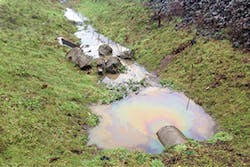Using a Geographic Information System (GIS) to Identify Illicit Discharges
The city of Eugene’s decision to use a geographic information system (GIS) to identify potential sources of illicit discharges occurred in 2009 when an industrial facility’s aboveground storage tank leaked approximately 730 gallons of off-road diesel in close proximity to the stormwater conveyance system, which discharges to the Willamette River via a 90-inch storm sewer line. Although the spill was formally reported by the industry shortly after it occurred, it was believed that the majority of the material had been captured onsite and would be addressed appropriately. However, due to a previously unknown storm sewer connection from an antiquated private system and light rain overnight, some of this material was discharged to the Willamette River in an area with high public visibility.
Fortunately, in this situation the business that was responsible for the spill properly self-reported the release to the Oregon Emergency Response System in accordance with Oregon state environmental law. Without this notification, city staff (who had to be called in as the discharge occurred on a weekend) would have had to spend a considerable amount of time tracing the spill through the stormwater conveyance system in hope of identifying the source, because a 17-mile section of stormwater piping discharges to this outfall. This event identified the need for the City to develop a way to quickly identify what materials local businesses were storing onsite.
Creating a Database of Potential Sources of Illicit Discharges
Even if a municipality ultimately decides not to link this information to a GIS system, it is important to know what materials businesses are storing onsite and where these materials would go if they were to be spilled. The city of Eugene has created a hazardous material database that comprises information from the Toxics Right-to-Know Database (created by the city in 1996, requiring certain manufacturers to provide information to the public concerning the use and disposition of federally listed hazardous substances), General Industrial Stormwater Discharge Permit files, and Industrial Wastewater Pretreatment Permit files, which generated a list of industrial facilities that stored hazardous materials onsite. Once this list was created, the phone book and the Oregon Labor Market Information System were used to identify other businesses that had a high likelihood of storing significant quantities of hazardous materials onsite. These businesses included gas stations, auto body shops, paint stores, and dry cleaners.
Illicit discharge
The list of businesses was created in a Microsoft Access table that included each facility address, contact information, and information related to the hazardous material inventory. Each business was assigned a five-digit unique identification number, which was used as the primary key; the first digit in the number corresponds to the industrial activity that is conducted at the facility. For example: 5-,— was assigned to dry cleaners and 7-,— was assigned to gas stations. This method of assigning identification numbers makes it easier to update and cross-reference information in the database. To help cross-reference the database in other ways, there is a column for each part of the address (street number, street name, street type, direction), and capital letters were used for all text. By populating the database in this fashion, it made it easier to delete multiple entries and made it possible to utilize the city’s GIS data, which was in the same format.
Once the list of businesses was created, a list of commonly stored hazardous materials that could be easily identified at a stormwater outfall was added. The materials included are as follows: gasoline, diesel, motor oil, antifreeze, kerosene, formaldehyde, lubricant, solvent, paint, hydraulic fluid, acid, and chlorine. If the material was suspected to be present at a particular site, a “1” was entered into the column, and a “0” was entered if the material was not suspected to be stored onsite. There were a number of different materials that only occurred at a handful of sites, so a field entitled “Other” was created to account for these materials in the interest of creating a manageable table.
The locations these hazardous materials would enter the municipal storm sewer system in the event of a spill was identified by zooming to each industrial site and identifying the Structure ID of a nearby stormwater catch basin or manhole using ArcGIS. If a facility is located in an area where the stormwater drainage from the site flows into two different drainage basins, the site was entered into the data table twice so each of the discharge locations could be properly identified. The city has not mapped privately owned stormwater systems, and occasionally a connection that was present on the ground wasn’t displayed on the storm system geodatabase. In this event, the next structure upstream of where the connection was supposed to be was identified. The Structure ID of the stormwater outfall for each inlet was also added to the table so it could be used as a standalone document.


